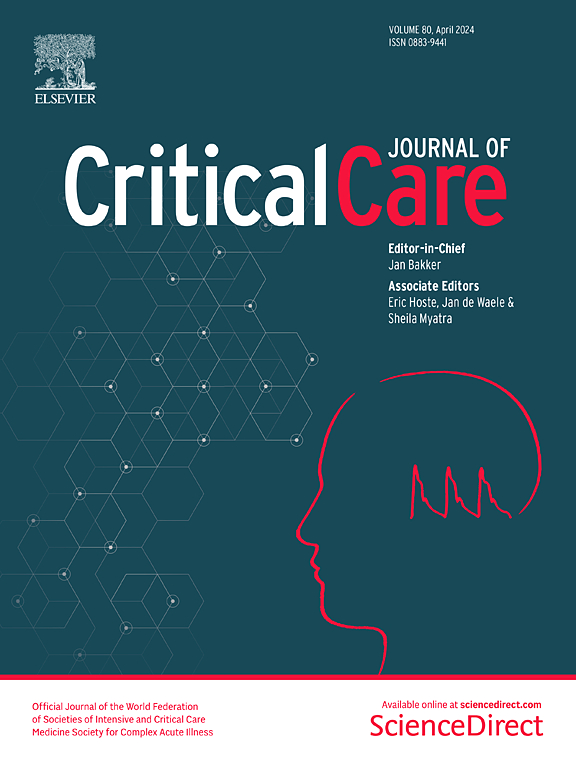Biomarkers in acute kidney injury settings to predict interventions and outcomes: the MARKISIO study
IF 8.8
1区 医学
Q1 CRITICAL CARE MEDICINE
引用次数: 0
Abstract
Predicting the need for renal replacement therapy (RRT) in acute kidney injury (AKI) remains challenging. The utility of biomarkers was explored during previous studies which were biased as RRT indications relied on clinician opinion rather than evidence. Those studies preceded trials that clarified RRT initiation criteria. We aimed to assess biomarkers in predicting criteria for RRT initiation in severe AKI patients. This is an ancillary study of the AKIKI2 trial. Patients with severe AKI (stage 3) receiving invasive mechanical ventilation and/or vasopressors were included. Blood and urine samples were collected within 12 h after the occurrence of severe AKI when feasible, depending on the availability of trained research staff and appropriate sample storage infrastructure. The primary endpoint was the onset of precise criteria for RRT initiation within 72 h after severe AKI. We analyzed routine serum biomarkers (pH, serum potassium, serum creatinine) and novel urinary and serum biomarkers (CCL14, KIM1, nicotinamide and its metabolites, cDPP3, plasma proenkephalin A 119-159). Among the 256 patients, 101 (39%) met at least one criterion for RRT initiation or died within 72 h. No biomarker demonstrated satisfactory predictive performance for the primary endpoint. No novel biomarker was significantly associated with the occurrence of MAKE60. In multivariable analysis, ‘SAPSIII’ and ‘Serum potassium level at D0’ were significantly associated with the occurrence of MAKE60. Neither routine nor novel biomarkers demonstrated conclusive predictive accuracy for the need for RRT in severe AKI patients. Given evidence-based criteria for initiating RRT, the tested biomarkers may not effectively guide RRT initiation.急性肾损伤环境中的生物标志物预测干预措施和结果:MARKISIO研究
预测急性肾损伤(AKI)患者是否需要肾替代治疗(RRT)仍然具有挑战性。在以前的研究中探索了生物标志物的效用,这些研究存在偏见,因为RRT适应症依赖于临床医生的意见而不是证据。这些研究先于澄清RRT起始标准的试验。我们的目的是评估生物标志物在预测严重AKI患者RRT启动标准中的作用。这是AKIKI2试验的辅助研究。接受有创机械通气和/或血管加压药物治疗的严重AKI(3期)患者纳入研究。根据训练有素的研究人员的可用性和适当的样本储存基础设施,在可能的情况下,在严重AKI发生后12小时内收集血液和尿液样本。主要终点是在严重AKI后72小时内开始RRT的精确标准。我们分析了常规血清生物标志物(pH、血清钾、血清肌酐)和新的尿液和血清生物标志物(CCL14、KIM1、烟酰胺及其代谢物、cDPP3、血浆脑啡肽A 119-159)。在256例患者中,101例(39%)至少满足RRT开始的一个标准或在72小时内死亡。没有生物标志物显示出令人满意的主要终点预测性能。没有新的生物标志物与MAKE60的发生显著相关。在多变量分析中,“SAPSIII”和“D0时血清钾水平”与MAKE60的发生显著相关。常规和新型生物标志物都不能准确预测严重AKI患者是否需要RRT。鉴于启动RRT的循证标准,测试的生物标志物可能无法有效指导RRT的启动。
本文章由计算机程序翻译,如有差异,请以英文原文为准。
求助全文
约1分钟内获得全文
求助全文
来源期刊

Critical Care
医学-危重病医学
CiteScore
20.60
自引率
3.30%
发文量
348
审稿时长
1.5 months
期刊介绍:
Critical Care is an esteemed international medical journal that undergoes a rigorous peer-review process to maintain its high quality standards. Its primary objective is to enhance the healthcare services offered to critically ill patients. To achieve this, the journal focuses on gathering, exchanging, disseminating, and endorsing evidence-based information that is highly relevant to intensivists. By doing so, Critical Care seeks to provide a thorough and inclusive examination of the intensive care field.
 求助内容:
求助内容: 应助结果提醒方式:
应助结果提醒方式:


